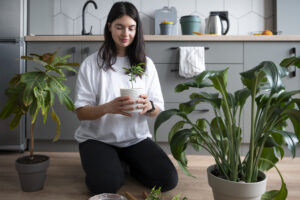 Creating a healthier home environment is about transforming your living space into a place that nurtures your well-being, reduces stress, and promotes positive energy. You can boost your air quality to maximize natural light, even small adjustments that can make a big difference in how your home feels and functions. By incorporating natural materials, decluttering, and choosing eco-friendly options, you can turn your home into a calming retreat that supports your health every day. In this article, let us explore some practical steps to help you build a home that truly enhances your lifestyle and well-being.
Creating a healthier home environment is about transforming your living space into a place that nurtures your well-being, reduces stress, and promotes positive energy. You can boost your air quality to maximize natural light, even small adjustments that can make a big difference in how your home feels and functions. By incorporating natural materials, decluttering, and choosing eco-friendly options, you can turn your home into a calming retreat that supports your health every day. In this article, let us explore some practical steps to help you build a home that truly enhances your lifestyle and well-being.
Key Tips to Create a Healthier Home Environment
Here are some practical steps to help you build a healthier home environment:
1. Focus on Indoor Air Quality

Improving indoor air quality is one of the most impactful ways to create a healthier home environment. One simple approach is to add indoor plants like spider plants, peace lilies, and snake plants. These natural air purifiers absorb toxins and release oxygen, enhancing overall air quality. Additionally, investing in a quality air purifier with a HEPA filter can trap dust, pollen, and airborne pollutants, helping to create a cleaner indoor atmosphere. Regular ventilation, such as opening windows, helps fresh air circulate and removes stale indoor air. It’s also beneficial to avoid synthetic air fresheners, as many contain chemicals that lower air quality. Natural air fresheners or essential oils serve as a healthier alternative, offering pleasant scents without harmful toxins.
2. Choose Non-Toxic Materials and Furnishings
 The materials used for furniture, paint, and flooring significantly affect the healthiness of your home. Opting for low or zero-VOC (volatile organic compound) paints helps improve air quality, as these paints emit fewer toxins than conventional options. For textiles, choose natural materials like organic cotton, wool, and linen, which are safer for indoor environments and reduce exposure to harmful chemicals. Eco-friendly furniture made from sustainably sourced wood or recycled materials not only supports a healthier home environment but also contributes to environmental sustainability. This conscious choice of materials can transform your space into a toxin-free, comfortable haven.
The materials used for furniture, paint, and flooring significantly affect the healthiness of your home. Opting for low or zero-VOC (volatile organic compound) paints helps improve air quality, as these paints emit fewer toxins than conventional options. For textiles, choose natural materials like organic cotton, wool, and linen, which are safer for indoor environments and reduce exposure to harmful chemicals. Eco-friendly furniture made from sustainably sourced wood or recycled materials not only supports a healthier home environment but also contributes to environmental sustainability. This conscious choice of materials can transform your space into a toxin-free, comfortable haven.
3. Let in Natural Light

Maximizing natural light in your home boosts mood and creates a brighter, healthier home environment. Start by painting walls in light colors, such as whites, creams, and pastels, which reflect natural light and make rooms feel open and airy. Strategically placed mirrors can also amplify natural light by reflecting it across the room. Using sheer curtains is another effective way to let more sunlight in while maintaining privacy. Finally, keeping window areas clear of furniture and clutter allows sunlight to fill the room, creating a vibrant and welcoming space.
4. Reduce Clutter for Mental Clarity

A clutter-free space can reduce stress and foster a more relaxed atmosphere. Embracing minimalist principles and limiting belongings to essential items or those that bring joy can help maintain a sense of order. Functional storage solutions, such as baskets, bins, and furniture with hidden compartments, allow you to organize items neatly and out of sight. Additionally, practicing daily decluttering—even if it’s just for a few minutes—helps keep clutter under control and ensures your space remains a sanctuary of calm and clarity.
5. Opt for Eco-Friendly Cleaning Products
 Many conventional cleaners contain harsh chemicals that can negatively impact your home environment. Green cleaning products offer a safer alternative, as they are biodegradable and free from toxins that can compromise air quality. If you prefer a DIY approach, natural ingredients like white vinegar, baking soda, and lemon juice can be used to clean most surfaces effectively and safely. Regular cleaning, using eco-friendly methods, also helps reduce dust, allergens, and mold buildup, all of which contribute to a healthier home.
Many conventional cleaners contain harsh chemicals that can negatively impact your home environment. Green cleaning products offer a safer alternative, as they are biodegradable and free from toxins that can compromise air quality. If you prefer a DIY approach, natural ingredients like white vinegar, baking soda, and lemon juice can be used to clean most surfaces effectively and safely. Regular cleaning, using eco-friendly methods, also helps reduce dust, allergens, and mold buildup, all of which contribute to a healthier home.
6. Designate Relaxation and Mindfulness Spaces
 Having designated areas for relaxation can greatly enhance mental wellness. Creating a quiet corner, perhaps with a comfortable chair, natural lighting, and calming decor, can serve as a personal space for reading, meditation, or quiet reflection. Using calming colors like soft blues, greens, and neutrals in these areas adds to the peaceful ambiance. Cozy textures, such as blankets, cushions, and soft rugs, further enhance comfort, making these spaces perfect for unwinding and recharging.
Having designated areas for relaxation can greatly enhance mental wellness. Creating a quiet corner, perhaps with a comfortable chair, natural lighting, and calming decor, can serve as a personal space for reading, meditation, or quiet reflection. Using calming colors like soft blues, greens, and neutrals in these areas adds to the peaceful ambiance. Cozy textures, such as blankets, cushions, and soft rugs, further enhance comfort, making these spaces perfect for unwinding and recharging.
7. Integrate Natural Materials
 Incorporating organic elements like wood and stone can give your home a welcoming, earthy feel, supporting both health and sustainability. Wooden furniture, especially when made from natural or sustainably sourced wood, adds warmth and a sense of grounding to your space. Similarly, adding accents in stone or ceramic—like a marble countertop or stone table—can add texture and depth. Bamboo and cork flooring are sustainable, eco-friendly options that have low VOC emissions and contribute to a healthier indoor atmosphere.
Incorporating organic elements like wood and stone can give your home a welcoming, earthy feel, supporting both health and sustainability. Wooden furniture, especially when made from natural or sustainably sourced wood, adds warmth and a sense of grounding to your space. Similarly, adding accents in stone or ceramic—like a marble countertop or stone table—can add texture and depth. Bamboo and cork flooring are sustainable, eco-friendly options that have low VOC emissions and contribute to a healthier indoor atmosphere.
8. Control Humidity Levels
 Maintaining balanced humidity levels is essential to prevent mold growth and minimize allergens. Using a dehumidifier in moisture-prone areas like basements or bathrooms can help keep humidity in check. Ventilating damp spaces by using exhaust fans in bathrooms and kitchens can prevent moisture buildup. Sealing any cracks and fixing leaks promptly also helps to control humidity levels and avoid mold issues, creating a cleaner and healthier home environment.
Maintaining balanced humidity levels is essential to prevent mold growth and minimize allergens. Using a dehumidifier in moisture-prone areas like basements or bathrooms can help keep humidity in check. Ventilating damp spaces by using exhaust fans in bathrooms and kitchens can prevent moisture buildup. Sealing any cracks and fixing leaks promptly also helps to control humidity levels and avoid mold issues, creating a cleaner and healthier home environment.
9. Incorporate Biophilic Design
 Biophilic design, which integrates natural elements indoors, is known to enhance well-being and reduce stress. Adding a green wall or a vertical garden with various indoor plants can serve as both a decorative feature and an air purifier. Water features, such as small fountains or aquariums, add a touch of tranquility to your space. You can also incorporate natural scents like lavender, eucalyptus, or cedarwood to create a nature-inspired aroma that is both refreshing and calming, further supporting a healthier home.
Biophilic design, which integrates natural elements indoors, is known to enhance well-being and reduce stress. Adding a green wall or a vertical garden with various indoor plants can serve as both a decorative feature and an air purifier. Water features, such as small fountains or aquariums, add a touch of tranquility to your space. You can also incorporate natural scents like lavender, eucalyptus, or cedarwood to create a nature-inspired aroma that is both refreshing and calming, further supporting a healthier home.
10. Invest in Ergonomic Furniture
 Ergonomic furniture supports physical health, reducing strain and making living spaces more comfortable. This is especially important for home offices. Adjustable chairs with proper lumbar support ensure comfort during extended periods of sitting. A standing desk offers flexibility, allowing you to alternate between sitting and standing, which can alleviate back strain. Good lighting, particularly task lighting for reading or working, reduces eye strain and creates a more comfortable and functional space for daily activities.
Ergonomic furniture supports physical health, reducing strain and making living spaces more comfortable. This is especially important for home offices. Adjustable chairs with proper lumbar support ensure comfort during extended periods of sitting. A standing desk offers flexibility, allowing you to alternate between sitting and standing, which can alleviate back strain. Good lighting, particularly task lighting for reading or working, reduces eye strain and creates a more comfortable and functional space for daily activities.
Conclusion
Creating a healthier home environment doesn’t require drastic changes. Small adjustments, such as improving air quality, choosing non-toxic materials, maximizing natural light, and reducing clutter, add up to a significant impact on well-being. A healthier home environment supports both physical and mental health, providing a space where you can truly relax, recharge, and thrive. Making your home healthier and more uplifting is an investment that pays off daily, enhancing your quality of life.
Ready to turn your home dream into reality? Book an appointment with E³.SPACE, and let us bring your vision to life.

